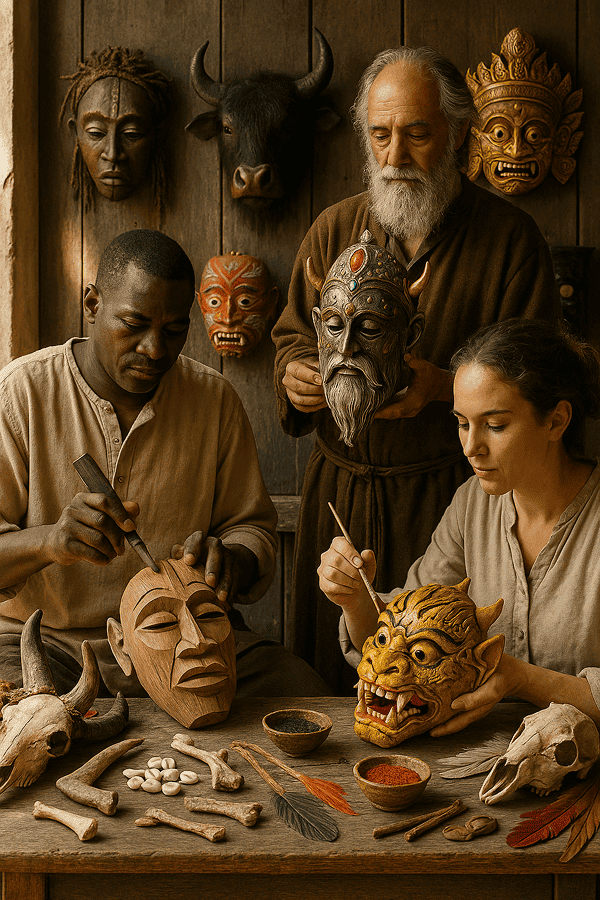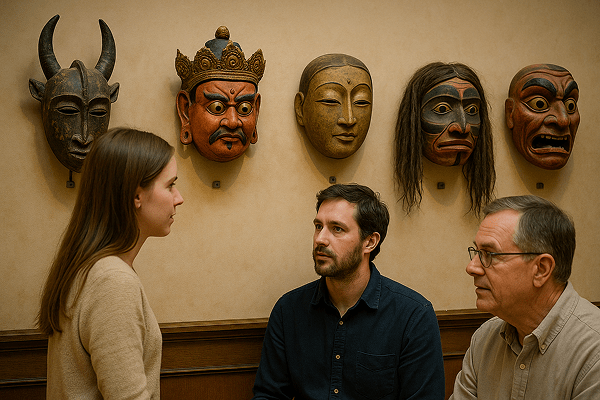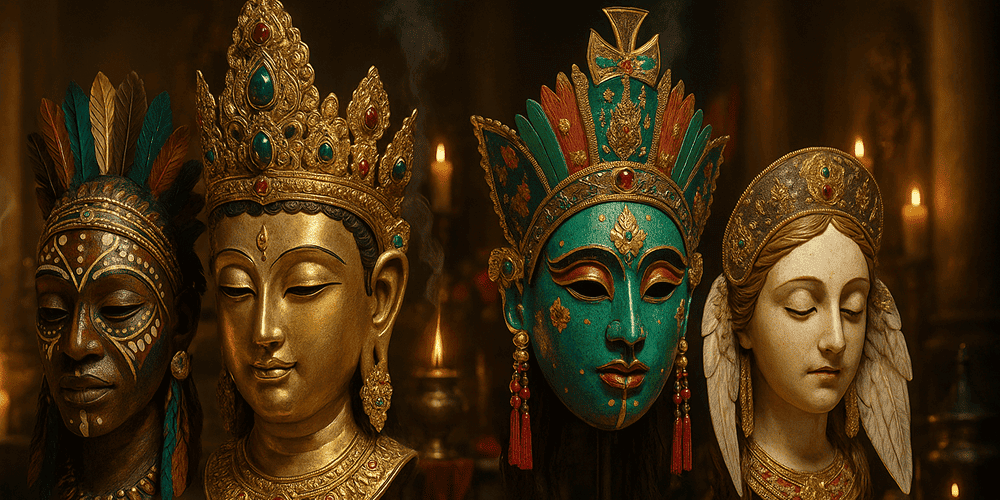Religious Ceremony Masks are among the most sacred and artistically complex artifacts in the world’s ritual traditions. These masks are crafted and worn to embody deities, spirits, ancestors, or mythological beings during religious ceremonies and festivals. Their appearance is often striking and highly symbolic, featuring stylized human faces, animal motifs, geometric patterns, or divine iconography. Religious masks can be found on every continent, from the elaborate wooden masks of West Africa and the Himalayas to the painted papier-mâché of Japanese Shinto ceremonies and the intricate beadwork of Native American rituals. While their origins are ancient, Religious Ceremony Masks continue to play a vital role in spiritual life, community identity, and artistic innovation. Platforms like toddmasks.com offer collectors and enthusiasts a window into this tradition. For those interested in the intersection of religion and the rhythms of nature, see also articles on Seasonal Ceremony Masks.
Historical Origins of Religious Ceremony Masks
The use of masks in religious ceremonies traces back to prehistoric times, when early humans sought to communicate with the unseen world. The word “mask” is derived from the Latin “masca,” meaning spirit or ghost, and in many cultures, masks are seen as vessels for supernatural power. Archaeological evidence suggests that masks were used in ancient Egypt, Sumer, Greece, and Mesoamerica to honor gods, mark rites of passage, or protect the living from evil.
Over time, the design and function of religious masks evolved in response to changing beliefs, regional influences, and artistic trends. In Africa, masks became central to ancestor worship, initiation rituals, and harvest festivals. In Asia, they were used in Buddhist, Hindu, Shinto, and Taoist ceremonies, often representing divine beings or mythic heroes. In the Americas, indigenous peoples used masks in dances and rituals to ensure harmony, fertility, or successful hunts. Significant historical artifacts—such as the Dogon Kanaga masks, Tibetan Cham masks, and Hopi Kachina masks—are preserved in museums and sacred sites worldwide.
Cultural Significance and Symbolism of Religious Ceremony Masks
Religious Ceremony Masks are imbued with profound symbolic meaning. In their cultures of origin, they are not merely decorative objects, but sacred tools for transformation, communication, and protection. Masks may represent ancestors, gods, or spirits who are believed to guide, bless, or challenge participants during ceremonies.
Spiritually, the act of donning a mask allows the wearer to transcend the human realm and embody the divine, serving as a conduit for ritual power. Myths and legends often surround religious masks, describing their origins, powers, and proper use. Socially, masks reinforce group identity, hierarchy, and continuity of tradition. In some societies, only initiated elders, priests, or shamans may touch or wear the masks, maintaining their sanctity and potency.
Religious masks also function as teaching tools, transmitting stories, moral lessons, and cultural values to new generations. They may be used in exorcisms, healing rites, funerals, weddings, and major seasonal festivals, reflecting the full spectrum of communal life.
Materials and Crafting Techniques of Religious Ceremony Masks
The creation of Religious Ceremony Masks is a sacred craft, often guided by strict rules and spiritual protocols. Traditional materials include:
- Carved wood (iroko, cedar, sandalwood, etc.)
- Clay, papier-mâché, or gourd
- Animal hides, feathers, shells, teeth, bone, and horn
- Metal (bronze, copper, silver, gold)
- Beads, textiles, and natural pigments

The process usually involves:
- Selecting and spiritually preparing the materials (sometimes with offerings or prayers)
- Carving, molding, or weaving the base form
- Painting, staining, or applying natural dyes and minerals
- Embellishing with symbolic elements such as beads, feathers, mirrors, or stones
- Consecrating the mask through ritual, song, or sacrifice
Special techniques include layered carving, transformation mechanisms, and the use of hidden compartments or articulated parts. Regional differences are significant: West African masks are known for bold patterns and geometric lines, Himalayan masks for fierce expressions and gold leaf, Japanese masks for minimalist elegance, and Native American masks for naturalistic animal features. Color symbolism is deeply meaningful—red for vitality, white for purity, black for ancestor power, gold for divinity, and blue for cosmic energy.
Functions and Uses of Religious Ceremony Masks
Religious Ceremony Masks are used in a wide range of contexts:
- Ritual and ceremonial: Worn during initiation rites, ancestor worship, funerals, healing ceremonies, and seasonal festivals.
- Theatrical application: Central to sacred dances, myth reenactments, and exorcism rituals.
- Festival and public celebration: Featured in processions, parades, and community gatherings.
- Modern application: Sometimes adapted for contemporary performances, museum education, or art installations.
The use of religious masks has changed over time, with some traditions preserved intact and others adapted to new social or artistic contexts.
Regional Variations of Religious Ceremony Masks
Religious masks reflect the diversity of spiritual traditions worldwide:
- Africa: Dogon, Bwa, and Yoruba masks for ancestor worship and initiation. Pende and Chokwe masks for fertility and healing.
- Asia: Tibetan Cham masks for Buddhist ceremonies, Japanese Noh and Shinto masks, Indian Kathakali masks for Hindu epics.
- Americas: Hopi and Zuni Kachina masks, Iroquois False Face Society masks, Mayan and Aztec ritual masks.
- Europe: Medieval mumming and mystery play masks, Greek tragedy masks, Slavic folk festival masks.
Each region’s masks are distinguished by unique materials, designs, and ritual uses, but all share the goal of connecting the human and the divine.
Famous Examples and Notable Collections of Religious Ceremony Masks
Notable religious masks are preserved in leading museums:
- British Museum (London): African, Oceanic, and Asian religious masks.
- Musée du quai Branly (Paris): Global sacred mask collections.
- Metropolitan Museum of Art (New York): Masks from Africa, Asia, and the Americas.
- Smithsonian National Museum of the American Indian (Washington, D.C.): Native American ritual masks.
Private collections, tribal museums, and monasteries also house rare and sacred masks, many of which are only displayed on special occasions. For digital galleries and expert commentary, visit toddmasks.com.

Influence of Religious Ceremony Masks on Art and Culture
Religious Ceremony Masks have profoundly influenced global art, theater, music, and literature. Modern artists such as Picasso, Matisse, and Derain drew inspiration from African masks. In performance, religious masks shape the aesthetics of dance, opera, and ritual drama.
In literature and cinema, religious masks symbolize transformation, the sacred, and the mystery of existence. Fashion designers and architects reference mask motifs in their work, while musicians use masks as visual and symbolic elements on stage. The preservation and study of religious mask traditions are essential for maintaining cultural heritage and fostering cross-cultural understanding.
Contemporary Status and Preservation of the Religious Mask Tradition
Today, the tradition of Religious Ceremony Masks is vibrant but faces challenges from modernization, religious change, and cultural appropriation. Master carvers and mask-makers continue to pass down skills through apprenticeships, workshops, and festivals. Museums and cultural institutions sponsor exhibitions, conservation projects, and community events.
Modern adaptations include eco-friendly materials, digital documentation, and collaborations with artists and scholars. Online resources like toddmasks.com provide educational content, artisan interviews, and access to global collections. Preservation efforts focus on respecting sacred contexts, supporting indigenous artisans, and ensuring ethical stewardship.
Collecting and Acquiring Religious Ceremony Masks
The collector’s market for Religious Ceremony Masks is diverse, ranging from accessible contemporary pieces to rare, museum-quality artifacts. Authentic masks can be found in galleries, museum shops, auctions, and reputable online platforms such as toddmasks.com. Factors affecting value include:
- Material and craftsmanship
- Age, provenance, and ritual use
- Artistic reputation and documentation
- Cultural sensitivity and ethical sourcing
Collectors should support living artisans, seek documentation, and avoid acquiring masks with ongoing sacred significance to living communities.
